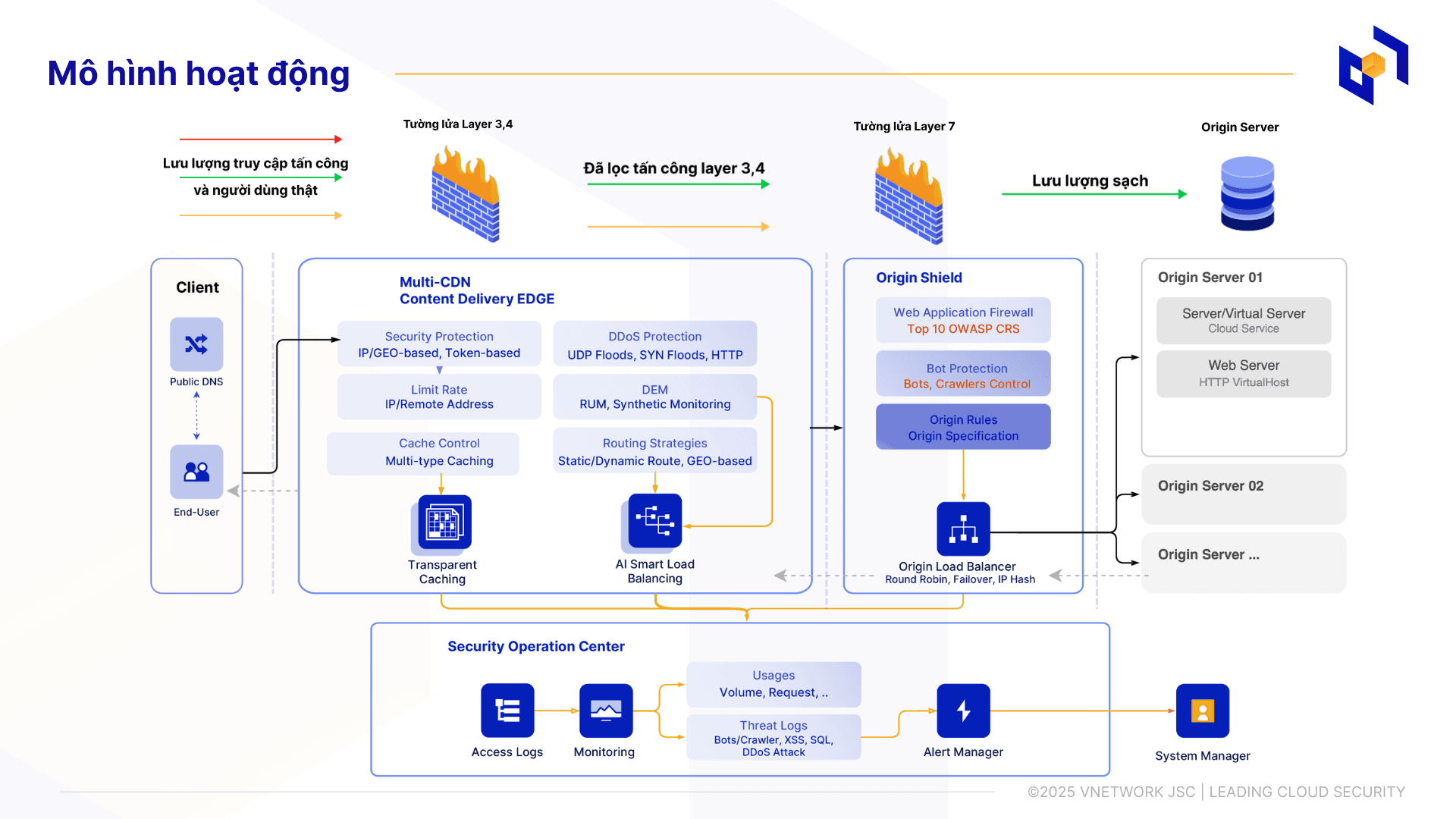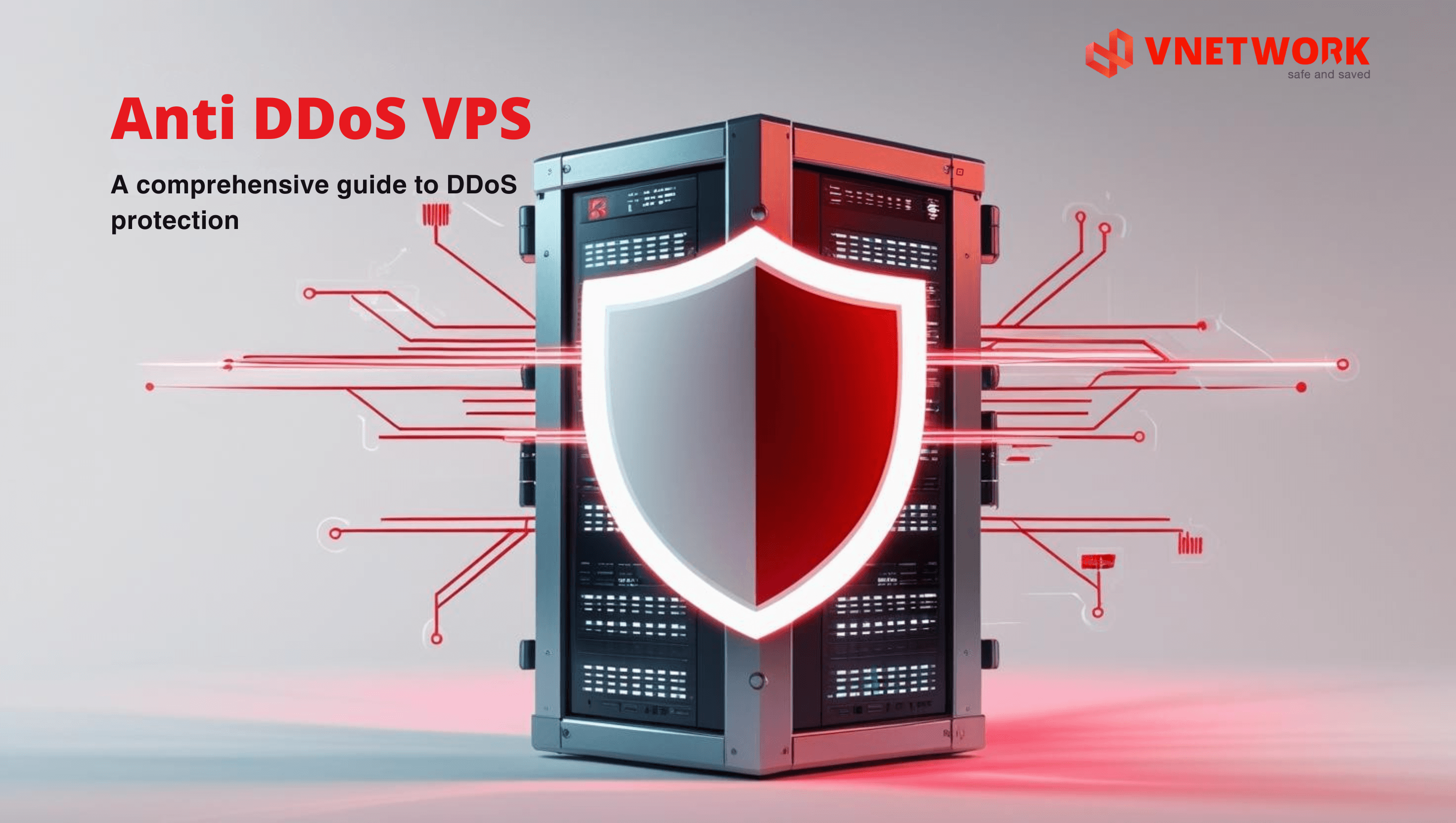What is anti-DDoS?
Anti-DDoS (short for Anti-Distributed Denial of Service) is a collection of techniques, technologies, and processes designed to combat distributed denial-of-service attacks. The goal of Anti-DDoS is to detect, filter, and block malicious traffic, ensuring that system resources like CPU, RAM, and bandwidth are not depleted and that legitimate users can still access the service normally.
Without this defensive layer, a DDoS attack can cause:
- Bandwidth congestion: Millions of fraudulent requests flood in, clogging the connection.
- Server resource exhaustion: The server becomes overloaded and cannot process legitimate requests.
- Service paralysis: The website or application becomes inaccessible, completely halting operations.
Why are VPSs frequent targets for DDoS attacks?
Compared to dedicated servers, a VPS has more limited resources, making it a "soft target" for attackers. An attacker can easily exhaust the bandwidth or CPU/RAM resources of a virtual server with a moderately sized attack.
Common forms of DDoS attacks on VPS include:
- Volume-based attacks: This is the most common type. Attackers use a network of compromised computers (a botnet) to generate a massive flood of traffic, overwhelming the VPS's bandwidth.
- Protocol attacks: This form exploits weaknesses in network protocols (like TCP, ICMP) to exhaust the processing resources of the server or firewall.
- Application layer attacks (Layer 7): Considered the most sophisticated and dangerous type, these attacks target specific web applications (e.g., continuously sending login or search requests). They are very difficult to detect because they mimic the behavior of real users.
Learn more about
what a ddos attack is.
What is a VPS?

Guide to common (self-implemented) anti-DDoS methods
Layer 7 is the most frequently targeted layer because Internet Service Providers (ISPs) typically only offer users protection against Layer 3 and Layer 4 DDoS attacks. Attackers exploit this vulnerability, leaving the business's protective layer compromised.
Businesses can implement basic DDoS protection such as:
Preventing DDoS via iframes:
An attacker can insert an iframe of your website onto a high-traffic site, running commands that create security risks or spread malware.
To counter this, you need to insert a JavaScript snippet to prevent your site from being framed by other websites:
HTML
<script language="JavaScript">
if (top.location != self.location)
{top.location = self.location}
</script>Preventing malicious page reloads:
Another attack method involves hackers using a command or software to continuously reload your webpage. This type of attack consumes bandwidth with fraudulent connections, causing your website to slow down.
You can use a .htaccess file with the following content:
Apache
RewriteEngine on
RewriteCond %{HTTP_REFERER} !^http(s)?://(www.)?domain.com [NC]
RewriteRule !antiddos.phtml http://www.domain.com/antiddos.phtml?%{REQUEST_URI} [QSA]
Next, create a file named antiddos.phtml with the following content:
PHP
<?
$text = $HTTP_SERVER_VARS['QUERY_STRING'];
$text = preg_replace("/php&/si",'php?',$text);
echo('<center><a href=http://www.domain.com/?'.$text.'><font color=red size=5 face=Monotype>[CLICK HERE TO ENTER]</font></a></center>');
?>Finally, upload these two files to your website's root directory to complete the setup.
Professional and effective anti-DDoS VPS solutions
The manual methods above are only temporary fixes. For comprehensive website protection, businesses need more professional solutions.
1. Using a firewall
- Hardware Firewall: A dedicated physical device with high performance in filtering traffic and resisting medium-scale attacks.
- Software Firewall: Software installed on the VPS that can help block suspicious IPs sending excessive requests. However, it consumes the VPS's own resources and is ineffective once the bandwidth is already congested.
2. Using a content delivery network (CDN)
One of the most effective ways to counter Layer 7 DDoS attacks is by using a Content Delivery Network (CDN). A CDN acts as a buffer layer, hiding the origin IP address of the VPS. The attacker will only see the CDN's IP. Furthermore, with its global network of servers, a CDN distributes traffic, helping to reduce the load on the origin server and filter out malicious requests.
3. Using an anti-DDoS proxy
An Anti-DDoS Proxy acts as a "checkpoint" between the internet and your server. It provides specialized filters for Layers 3, 4, and 7, capable of identifying and stopping complex attacks like TCP SYN Floods, UDP Attacks, HTTP Attacks, and DNS Amplification. Typically, to use this service, a business needs to rent a VPS/Server from a provider that has it integrated.

VNIS - A comprehensive anti-DDoS solution for VPS from VNETWORK
When individual solutions are not enough to combat increasingly sophisticated attacks, you need a comprehensive security platform. VNIS by VNETWORK is the answer.
VNIS is a unified security solution that provides thorough Anti-DDoS for your company's VPS, regardless of which provider you use.
- Multi-layer DDoS protection: Comprehensive protection for Layers 3/4/7, defending against attacks targeting the OWASP top 10 security vulnerabilities.
- Massive mitigation capacity: A global network of Scrubbing Centers with a total capacity of up to 2,600 Tbps, ready to handle the largest attacks.
- Ensuring business continuity: Integrates smart Multi-CDN technology, automatically directing traffic through the best-performing CDNs to ensure the website stays online even during an attack.
- AI and 24/7 monitoring: AI Load Balancing technology combined with a Real User Monitoring (RUM) system helps detect and prevent unusual threats. A professional Security Operation Center (SOC) team monitors and is ready to assist 24/7.

Frequently asked questions (FAQ)
1. How much does anti-DDoS for VPS cost?
The cost depends on the scale and level of protection you need. Solutions like VNIS offer flexible service packages suitable for different regions and business sizes.
2. Can a CDN stop all types of DDoS attacks?
A CDN is very effective against application-layer (Layer 7) attacks and some volume-based attacks. However, to counter large-scale protocol-layer (Layer 3/4) attacks, you need a dedicated Anti-DDoS solution like VNIS.
3. My VPS is under a DDoS attack. What should I do immediately?
Contact your VPS service provider immediately. If they don't have a solution, seek out professional security services like VNIS. You can quickly integrate VNIS into your system to stop the attack.
Conclusion
DDoS attacks are a real and serious threat to any business using a VPS. Equipping your setup with a powerful Anti-DDoS VPS solution is no longer an option, but a mandatory requirement to ensure stable and secure business operations.
Don't wait until you're under attack. Protect your business today!
To integrate the comprehensive VNIS security solution, you can sign up for an account, choose a suitable service package, or contact us directly for a consultation.
